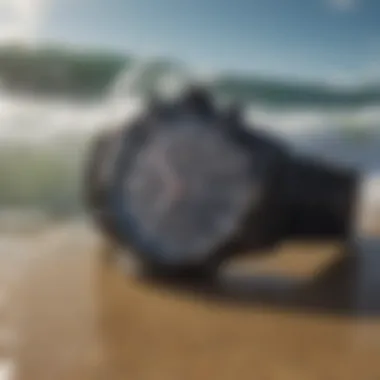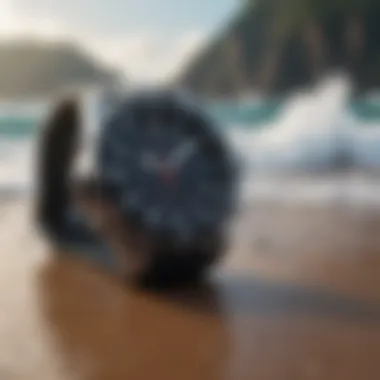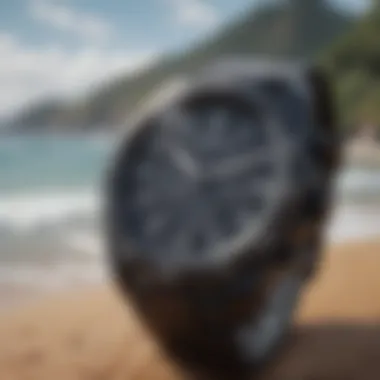The Essential Guide to Choosing a Surf Watch


Intro
Surfing is not just a sport; it is a culture, a lifestyle. For those who ride the waves, the experience is exhilarating yet demanding. Choosing the right watch for surfing is essential because it serves several purposes. Aside from telling the time, a suitable watch can enhance safety, performance, and overall enjoyment in the water. This guide addresses the necessary considerations when selecting a watch tailored for surfing.
Extreme Sport Overview
Surfing has a rich and storied history that dates back to ancient Polynesian culture. Initially, it was more than just a recreational activity; it was a part of society and ritual. In the 20th century, it evolved into a global sport, gaining enthusiasts around the world. The equipment required is minimalist but vital. A surfboard and a wetsuit are the most critical items, but a durable watch is also essential for keeping track of time, tides, and your progress.
Safety in surfing cannot be understated. Many ocean hazards exist, including strong currents, marine life, and unpredictable weather. To surf safely, one must understand the conditions and follow certain guidelines. Always surf with a buddy, know your limits, and stay aware of local rules and regulations.
Did you know? According to the International Surfing Association, an estimated 35 million people surf globally, showcasing the sport’s appeal and growth.
The Importance of Watch Features
When selecting a watch specifically for surfing, several features should be at the forefront of your mind:
- Water Resistance: A must-have feature. Look for a watch with at least 100 meters of water resistance.
- Durability: A good watch should withstand the rough conditions of ocean waves.
- Functionality: Tides, moon phases, and weather conditions can significantly affect surfing. Hence, a watch with this functionality is advantageous.
- Style: While performance is crucial, many surfers prefer a design that complements their personal style.
The intersection of functionality and aesthetic appeal is critical for many surfers. A stylish watch can reflect the individual's personality while meeting practical needs.
This guide aims to navigate the essential attributes and characteristics of watches for surfers. Before making a decision, consider how each feature aligns with your surfing habits and environmental conditions. The right watch will not only enhance performance and safety but will also be a stylish accessory for surfers, from novices to experts.
Understanding the Unique Needs of Surfers
Choosing a watch for surfing involves understanding the specific needs of surfers. Surfers face unique conditions. These include exposure to saltwater, intense sunlight, and high-impact situations. A watch must be more than a timepiece; it should serve functional purposes that cater to this dynamic lifestyle.
Surfers require watches that not only tell time but also assist in navigating the waves and ocean. They depend on accurate timekeeping to catch the best swells during the tide. A reliable watch can influence their performance and enjoyment. For both novice tyros and experienced surfers, the choice of watch can significantly affect their experience in the water.
The Role of Timekeeping in Surfing
Timekeeping plays a vital role in surfing. It is not just about knowing what time it is; it helps surfers plan their sessions. The tide schedules change regularly, and having precise timing can make or break a surf day. Many surfers rely on watches that feature tide charts or data to help them decide when to hit the water.
A quality surf watch should ideally have a countdown timer. This feature allows surfers to manage their time in the water effectively. Knowing how long they have until they must exit the water for safety or other commitments is essential. Therefore, reliable timekeeping ensures that surfers can maximize their time riding waves while being mindful of external factors like currents and weather changes.
Factors Influencing Watch Selection
Several factors influence the choice of a watch for surfing. These factors include:
- Water Resistance: Watches must withstand constant exposure to water. Surf watches often have higher water resistance ratings.
- Durability: Watches made with robust materials can resist scratches and impacts from falls and bumps.
- Comfort and Fit: A comfortable fit is essential, as a poorly fitting watch can be distracting and uncomfortable in the water.
- Visibility: Clear visibility in bright sunlight conditions is crucial. Surfing often involves navigating under strong sun rays.
Each of these factors contributes to making the right choice of watch. Surfers should evaluate how a watch meets these needs based on their specific surfing habits and environments.
Essential Features to Consider


Choosing a watch for surfing involves understanding certain essential features that directly impact performance and usability. A well-selected watch does more than just tell time; it serves various functional purposes tailored to the unique needs of surfers. It is crucial to consider elements like water resistance, durability of materials, and visibility of the display when selecting a timepiece. These features enhance the surfing experience and ensure the watch withstands the demands of aquatic adventures.
Water Resistance Ratings
The water resistance rating of a watch signifies its capability to endure exposure to water. This is paramount for surfers, as the watch gets consistently splashed and submerged. Most surfing watches have ratings measured in ATM (atmospheres) or meters. A watch rated at 10 ATM can typically handle water pressure equivalent to 100 meters, which is suitable for surfing. Rating systems often categorize watches into levels: splash-proof, water-resistant, and dive watches.
It is advisable to opt for a watch with at least a 10 ATM rating for surfing. This ensures not only resistance to water but also durability against the impacts of surfing conditions. Moreover, maintaining the watch's integrity through regular checks is vital for long-lasting performance in the surf.
Durability and Material Selection
Material choice directly affects a watch's durability. Surfers need a watch that can endure both saltwater and sunlight while withstanding physical impacts. Each material brings specific characteristics to the table, influencing both weight and resilience.
Metal
Metal watches, often constructed from stainless steel, are renowned for their robustness. The key characteristic of metal is its ability to resist corrosion, an essential feature for use in saltwater environments. Stainless steel provides a classic aesthetic, appealing to many surfers who prefer a stylish yet durable timepiece. However, one drawback is that metal can be heavier than other materials, which some surfers may find inconvenient during long sessions in the water.
Plastic
Plastic watches are light and generally more comfortable for long periods of wear. The primary advantage of plastic is its resistance to both shock and corrosion, making it a favorable choice for surfers. Many models come in vibrant colors, appealing to younger surfers looking for style. However, plastic may lack the longevity seen in metal options, as it can be more prone to scratches and fading over time.
Rubber
Rubber is a popular choice for surf watches. It provides significant flexibility and comfort while being waterproof. The soft elastomer material molds to the wrist and offers excellent grip, preventing slippage during vigorous activity. Rubber watches are lightweight, making them ideal for extended wear while surfing. However, one consideration is that rubber can deteriorate more rapidly than other materials, especially with prolonged exposure to sunlight and salt.
Visibility and Readability
When surfing, visibility is crucial. A watch must be easy to read under various lighting conditions, especially when reflected sunlight creates glare on the water. High-contrast displays, large numerals, and luminous features enhance readability. Additionally, anti-reflective coatings can significantly improve visibility, making it easier to keep track of time even in challenging situations. For surfers, having quick access to time information allows for better planning during sessions, ensuring they maximize their experience in the water.
Functionality Beyond Timekeeping
In the context of surfing, a watch is not just about telling time. Its functionality extends into various areas that enhance the surfing experience significantly. An effective surf watch combines timekeeping with essential features that provide critical data for surfers. This not only assists in improving their performance but also ensures their safety while engaging in the sport.
Tide and Wave Data Functions
Understanding tides and wave conditions is paramount for surfers. A watch equipped with tide and wave data functions offers critical information such as the best times to surf based on tide patterns. For instance, many watches can display tide charts and even filter data for specific locations, allowing the surfer to plan their session with precision.
A good example is the Rip Curl Search GPS watch, which also tracks your surfing session and logs wave count. This way, surfers can analyze their performance against the backdrop of changing ocean conditions. The integration of this feature into a watch can significantly elevate a surfer's experience by providing real-time insights.
GPS and Tracking Capabilities
GPS functionality has become an essential part of modern surf watches. This feature allows surfers to track their routes and speeds during their surfing sessions. Beyond simple tracking, advanced GPS capabilities can provide insights into surf fitness and enhance safety measures. Knowing the exact location and conditions can guide a surfer to safer spots or help them avoid potential hazards.
The Garmin Instinct Surf is known for its robust GPS functionality. Its ability to store and analyze surfing data makes it a valuable tool. Surfers can log their sessions, review their performance metrics, and tailor their training accordingly. This data-driven approach to surfing can optimize performance and improve overall surf techniques.


Weather and Temperature Monitoring
Weather conditions play a crucial role in surfing. A watch that provides weather forecasts and temperature readings can empower surfers to gauge when to head out. Features that indicate wind speed and direction, wave height, and water temperature offer a comprehensive view of conditions.
Watches like the Suunto 9 come equipped with these functionalities, making it easier to plan for the unexpected. Knowing if conditions will worsen or improve allows surfers to make informed decisions on the water, enhancing safety and enjoyment.
Effective watches do not merely tell time; they serve as supportive tools and informational hubs for surfers.
Top Brands and Their Offerings
Choosing a watch for surfing involves evaluating several brands that specialize in producing high-quality timepieces suited for aquatic conditions. The importance of this topic lies not just in choosing a watch, but in ensuring it meets the unique needs of surfers. Different brands offer various features, styles, and price points. Understanding these options can aid surfers in finding a watch that efficiently blends functionality with personal preference.
Popular Brands for Surf Watches
Casio
Casio watches are known for their robust construction and reliable features, which cater well to surfers. Their G-Shock series stands out due to its shock-resistant design and impressive water resistance ratings. One defining characteristic of Casio watches is value for money. They deliver vital functionalities without stretching the budget of serious surfers.
One unique feature of Casio is its solar-powered models. They utilize sunlight to recharge their batteries, which can be crucial during extended surfing trips. However, while they are durable and functional, some users find these watches bulky for everyday use.
Suunto
Suunto has established itself as a leader in performance watches, making it a favored choice for athletes, including surfers. The key characteristic of Suunto watches is their advanced tracking capabilities—for instance, they provide precise data on tides and wave heights. This aspect is particularly beneficial as it allows surfers to make informed decisions about the best times to hit the waves.
Another unique element is the Suunto app, which helps users track performance and connect with other athletes. However, some may find the interface challenging at first due to its comprehensive data features, which might overwhelm new users.
Garmin
Garmin has gained notoriety for integrating cutting-edge technology into their watches. One of the defining aspects of Garmin is its GPS functionalities, allowing surfers to track their rides and monitor routes on the water. Such capabilities add a technological edge to traditional timekeeping devices. Garmin watches also feature heart rate monitoring and fitness tracking, making them a versatile choice for athletes who engage in various sports. Nevertheless, some users may find the initial setup cumbersome, given the myriad of features tailored for different sports.
Rip Curl
Rip Curl specializes in surf-focused watches, making it a strong contender in this sector. Their design philosophy revolves around creating practical, stylish pieces. A key characteristic of Rip Curl watches is their ability to combine utility with fashion—many models look good on the beach and in casual environments. Particularly noteworthy is the Tide series, which provides tide information—vital for surfers. While they are generally functional, some models lack the durability found in other brands, especially under extreme conditions.
Comparative Analysis of Key Models
When evaluating watches, it is crucial to compare the key models from these brands based on features, durability, and price. This analysis can highlight the strengths and weaknesses of each watch, helping surfers to make informed choices that match their surfing style and preferences.
Considerations may include water resistance levels, battery life, display clarity under sunlight, and additional features like tide graphs or GPS tracking. With this comparative lens, finding the right watch can significantly enhance the surfing experience.
Ergonomics and Comfort in Design
Choosing a watch for surfing goes beyond functionality and style. Ergonomics and comfort play a critical role for surfers who spend long hours in the water. A well-designed watch should feel natural on the wrist and not interfere with surfing movements. Comfort allows the wearer to focus on their performance, making it a key consideration in the selection process.
Strap Material and Fit
The strap material directly impacts comfort. Different materials offer varying levels of flexibility and breathability. For instance, silicone and rubber straps are popular because they can withstand salty water and resist wear. They also offer good grip, reducing the chance of the watch slipping off. In contrast, metal straps can be heavy and cold, which might not be ideal for extended use in the ocean.


Moreover, the fit of the strap is equally significant. A watch that fits too tightly can cause discomfort and distraction, while one that is too loose may fall off during a wipeout. Look for adjustable straps that provide a secure but comfortable fit. Some brands even offer options with quick-release mechanisms, allowing surfers to customize their fit easily.
Weight and Size Considerations
The weight and size of a watch should be carefully evaluated as well. A heavy watch can be cumbersome when paddling out or catching waves, which can negatively influence performance. Ideally, the watch should be lightweight and compact, ensuring it does not weigh down the surfer or hinder their movements.
On the other hand, a watch that is too small might lack features or durability. Therefore, it's crucial to find that balance. A medium-size watch that feels light but has enough toughness and presence can be ideal.
Key Pointers to Remember:
- Opt for lightweight materials like silicone or rubber.
- Ensure the strap is adjustable for comfort and security.
- Consider the balance between size and functionality.
Maintenance and Care for Surf Watches
Taking proper care of a surf watch is crucial for both its functionality and longevity. Like all equipment used in extreme environments, a surf watch undergoes a lot of stress. Ocean water, humidity, and the impacts from surfing activities can quickly degrade its performance. Surfers need to understand maintenance requirements to ensure their timepiece continues to perform well. Regular care can prevent damage, extend the lifespan of the watch, and help maintain its appearance. Specifically, cleaning and proper care routines are vital components of effective watch maintenance.
Cleaning and Maintenance Tips
Maintaining a surf watch does not require advanced knowledge; however, a systematic approach can yield significant benefits. Here are practical steps to consider:
- Rinse After Use: Always rinse your watch with fresh water after every surf session. Saltwater and sand are harmful, and rinsing removes residues that can cause deterioration.
- Use a Soft Cloth: Wipe your watch with a soft, non-abrasive cloth to clean the surface. This prevents scratches and helps maintain clarity on the display.
- Check Seals Regularly: The gaskets and seals are essential for water resistance. Inspect them for cracks or wear signs, as damages can lead to water infiltration.
- Avoid Extreme Temperatures: Keep your watch away from extreme heat or cold. High temperatures can affect battery life and potentially warp materials.
- Store Properly: When not in use, store the watch in a dry, cool place. Avoid areas exposed to direct sunlight or humidity, as prolonged exposure can lead to fading and moisture buildup inside the watch.
These simple tips facilitate a thorough cleaning regimen that can help keep surf watches in working condition longer.
Ensuring Longevity of Performance
To ensure a surf watch remains reliable in performance, several guidelines should be incorporated into regular use and care:
- Battery Checks: Regularly check and replace the battery as needed. A dead battery can lead to inaccurate readings and a malfunction of features, especially for digital watches that rely on power for data functions.
- Professional Servicing: Consider professional servicing every few years. This can include pressure testing for water resistance, which is key for long-term performance.
- Calibration: For watches with advanced features, like GPS or tide tracking, always ensure they are calibrated correctly. Wrong calibration can lead to misleading information crucial for surfing.
- Monitor for Signs of Wear: Keep an eye out for signs of wear, including physical damage to the case or dial. Scratches, dents, and broken displays can impair functionality and decrease usability.
"Maintenance is not just about cleaning; it is about nurturing the essential functions of your watch. Ignoring routine care can have severe consequences."
Consequently, proper maintenance and care foster both functionality and top performance for surf watches, which is necessary for every dedicated surfer.
Closure: Making the Right Choice
When selecting a watch for surfing, several key elements come into play that can significantly affect your overall experience. This decision is not merely about choosing a functional timepiece but about finding one that aligns with your needs as a surfer. A well-chosen watch can enhance not just your performance in the water, but also your enjoyment of the sport.
The importance of this section lies in summarizing the critical aspects that have been previously discussed. From understanding the needs of surfers, considering essential features like water resistance and durability, to ensuring functionality that aligns with surfing activities, every factor contributes to making an informed choice. Furthermore, the aesthetic appeal of the watch should not be overlooked. A watch that complements your style can also boost your confidence while you ride the waves.
Summarizing Key Considerations
- Water Resistance: Ensure that the watch can handle immersion in water, particularly saltwater, which can be corrosive. Always check for an adequate water-resistance rating, typically at least 100 meters for surfing.
- Durability: Watches made from robust materials such as rubber, plastic, or stainless steel will serve better in a surfing environment. Consider models that can withstand impacts and abrasions.
- Functionality: Features like tide and wave monitoring, GPS capabilities, and even weather conditions can be invaluable. They provide essential data that can help in planning sessions and ensuring safety.
- Comfort and Fit: The design must allow comfort during lengthy surf sessions. An ergonomic strap and suitable weight are critical for a seamless experience.
- Maintenance: Good care of your watch extends its life. Simple practices, such as rinsing it after use and storing it properly, can prevent damage.
Final Recommendations for Buyers
In light of the discussed criteria, here are some recommendations for buyers:
- Assess Your Needs: Evaluate what features are most important to you—be it advanced tracking capabilities or simple timekeeping.
- Test the Fit: If possible, try on various models to ensure a comfortable fit on your wrist.
- Research Brands: Familiarize yourself with reliable brands such as Casio, Suunto, Garmin, and Rip Curl. Each offers a range of options that cater to different preferences.
- Read Reviews: Check customer feedback on performance and durability. Real-world experiences can provide insight not captured in product descriptions.
- Consider Warranty and Service: A good warranty and fast customer service are essential, particularly for devices used in harsh conditions.
Choosing the right watch for surfing ultimately enhances the overall experience. It allows you to focus on the waves rather than worrying about your equipment. Remember to weigh all factors carefully to ensure the timepiece meets your specific needs as a surfer.



